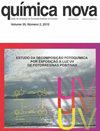低成本和易于获取的实验材料:液相色谱法分离食用色素的建议,作为一个有意义的学习经验
IF 0.5
4区 化学
Q4 CHEMISTRY, MULTIDISCIPLINARY
引用次数: 1
摘要
化学本科学生的实验活动对培养学生的科学技能和专业知识起着重要的作用,因此,实践实验课对实现这一目标至关重要。本文研究了用液相柱色谱法从食用色素样品中分离染料的实验经验。除了实验实践和可视化分离的设施之外,本演示还展示了如何使用替代和易于获取的材料进行简单的实验,一旦有可能处理获得的数据,跟踪和分析结果,从而培养技能而不是操作程序,就可以促进有意义的学习。这一建议可以在巴西大学的初级化学课程中实施。以海砂和河砂为固定相,以乙醇水溶液为流动相。选择一种食用色素(3种染料的混合物)作为研究样本。色谱分离后进行分光光度测定。对食用色素的溶解度进行了一系列分析,对所使用的固定相进行了粒度分析,并对所研究的沙子进行了电子显微镜成像。由于采用了替代材料,本文还采用低成本材料构建了色谱柱。本文章由计算机程序翻译,如有差异,请以英文原文为准。
LOW-COST AND EASY ACCESS MATERIALS FOR A LABORATORY CLASS: A PROPOSAL OF LIQUID CHROMATOGRAPHY FOR FOOD COLORING SEPARATION AS AN EXPERIENCE OF MEANINGFUL LEARNING
The experimental activities for undergraduate chemistry students play an important role to develop skills and expertise in that science thus, the practice-experimental classes are so important to achieve this purpose. This work deals with a demonstrative experience for dye separation from food coloring sample using liquid column chromatography. Beyond the experimental practice and the facility in visualizing the separation, this demonstration shows how a simple experiment involving alternative and easy access materials can promote a meaningful learning once it is possible to handle the acquired data, trace and analyze the results themselves, thus developing skills rather than the operational procedure. This proposal could be implemented in initial chemistry classes in Brazilian universities. Sea and river sands were used as stationary phases and aqueous ethanolic solutions were used as mobile phases. A food coloring (a mixture of 3 dyes) was chosen as sample to be studied. Chromatographic separation was followed by spectrophotometric measurements. A set of analyses were carried out to discuss the solubility of the food coloring, granulometric studies of the stationary phases used and electronic microscopy images of the sands studied here. As alternative materials were used in this work, a chromatographic column was also constructed with low-cost materials.
求助全文
通过发布文献求助,成功后即可免费获取论文全文。
去求助
来源期刊

Quimica Nova
化学-化学综合
CiteScore
1.60
自引率
12.50%
发文量
72
审稿时长
2-4 weeks
期刊介绍:
Química Nova publishes in portuguese, spanish and english, original research articles, revisions, technical notes and articles about education in chemistry. All the manuscripts submitted to QN are evaluated by, at least, two reviewers (from Brazil and abroad) of recognized expertise in the field of chemistry involved in the manuscript. The Editorial Council can be eventually asked to review manuscripts. Editors are responsible for the final edition of QN.
 求助内容:
求助内容: 应助结果提醒方式:
应助结果提醒方式:


